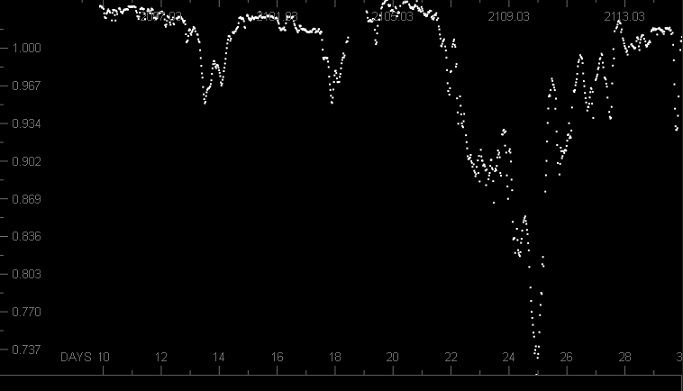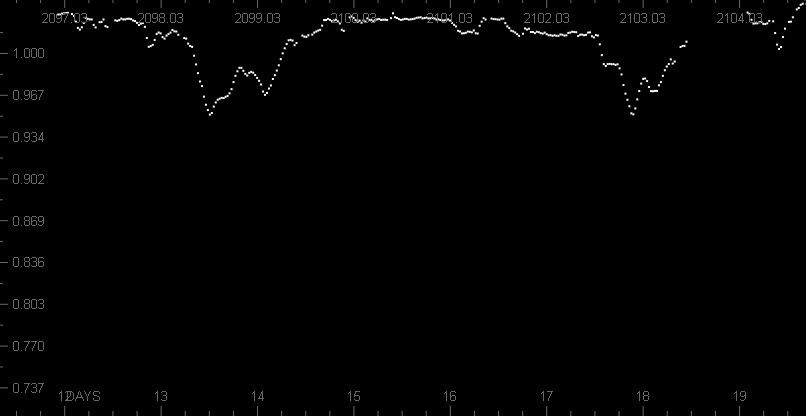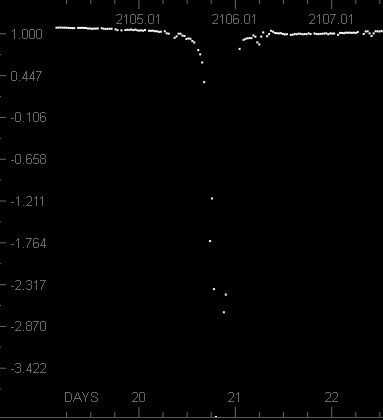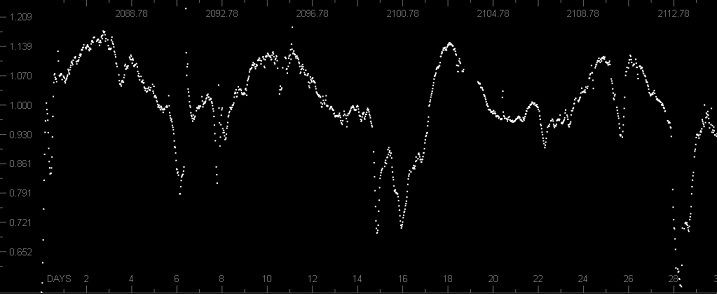Interesting LCs - Possible collision of comets or planetesimals and transitional disks?
-
 by
TED91
by
TED91
I was looking for some interesting light curves and I manage to find few of them. I hope that all of them aren't just some glitches. In case they aren't, it might turn out to be some collisions or transitional disks.
EPIC 204856535 - APH0000k55
Proposal numbers:
GO2003: Stellar activity of young stars as key for understanding the diversity of exoplanets: The case of Upper Scorpius OB association
GO2020: Finding transiting exoplanets in Upper Scorpius with Kepler K2
GO2052: K2 Monitoring of Confirmed Members of Upper Sco + Rho Oph
GO2056: A K2 Study of Young Stars in Upper Scorpius: Disk Effects, Stellar Activity, and Planets at 3-5 Myr
YSO in Upper Scorpius
SpType: M2, 0.490 solMass (Kraus+, 2007)
, Known companion (sep 11.65 arcsec) (Kraus+, 2009)https://www.cfa.harvard.edu/~avanderb/k2c2/ep204856535.html

This LC seems to be similar to this

EPIC 204078986 - APH0000ho1
Proposal numbers:
GO2010: Rotation of young brown dwarfs
GO2020: Finding transiting exoplanets in Upper Scorpius with Kepler K2
GO2045: Late-M and L Dwarfs in Kepler K2 Campaigns Two and Three
GO2047: Rotational Properties And Evolution Of Young Stars In Upper Sco: K2-field02
GO2052: K2 Monitoring of Confirmed Members of Upper Sco + Rho Oph
GO2085: Known members of rho Ophiuci and Upper Sco
GO2106: Search for Planets Transiting Bright M Dwarf Stars-Fields 2 and 3
Brown Dwarf in Upper Scorpius, 0.0273 Msun (Lodieu+, 2011)
New brown dwarf discs in Upper Scorpius (Dawson+, 2013)
https://www.cfa.harvard.edu/~avanderb/k2c2/ep204078986.html
EPIC 202135799 - APH0000c4r
Proposal numbers:
GO0119: TARGETING M DWARFS WITH K2
https://www.cfa.harvard.edu/~avanderb/k2c0/ep202135799.html

EPIC 203920354 - APH0000hbo
Proposal numbers:
GO2049: K2 campaigns 2 and 3 target proposal: Eclipsing Binary Stars
GO2085: Known members of rho Ophiuci and Upper Sco
Known companion (sep 10.5 arcsec) (Mason+ 2001-2014)
https://www.cfa.harvard.edu/~avanderb/k2c2/ep203920354.html

EPIC 203850058 - APH0000h04
Proposal numbers:
GO2033: Optical variability in Active Galactic Nuclei
GO2051: Galactic Archaeology on a grand scale - Campaigns 2-3
GO2052: K2 Monitoring of Confirmed Members of Upper Sco + Rho Oph
GO2085: Known members of rho Ophiuci and Upper Sco
GO2092: K2 Cycles 2 and 3: Transiting planets as a part of whole planetary systems
GO2114: Searching for Terrestrial Planets Orbiting Cool Stars and Brown Dwarfs with K2
SpT: M5.5/M6, known disk (MANARA+ 2015)
https://www.cfa.harvard.edu/~avanderb/k2c2/ep203850058.html
EPIC 204195987 - APH0000i2b
Proposal numbers:
GO2092: K2 Cycles 2 and 3: Transiting planets as a part of whole planetary systems
SpType M6.0 according to (HARVEY+, 2012)
(Hsieh+, 2013) , (Evans+, 2003), (Evans+, 2009)
https://www.cfa.harvard.edu/~avanderb/k2c2/ep204195987.html
EPIC 202081233 - APH000094r
Proposal numbers:
GO0107: A SEARCH FOR SMALL PLANETS IN AND NEAR THE HABITABLE ZONES OF SMALL STARS
GO0111: DETECTION OF EARTH-SIZE PLANETS USING K2
GO0120: NEARBY, HIGH PROPER MOTION M DWARFS FOR THE KEPLER K2 MISSION
https://www.cfa.harvard.edu/~avanderb/k2c0/ep202081233.html
EPIC 204512343 - APH0000j6a
Proposal numbers:
GO2051: Galactic Archaeology on a grand scale - Campaigns 2-3
GO2063:Planets Around Likely Young Stars in Upper Sco + Rho Oph
https://www.cfa.harvard.edu/~avanderb/k2c2/ep204512343.html

This one is really interesting, several possible deep transits. Looks like triple or maybe even quadruple system.
Posted
-
 by
Martti_Holst_Kristiansen
in response to TED91's comment.
by
Martti_Holst_Kristiansen
in response to TED91's comment.
Take a look at this post, I hope it helps:
http://talk.planethunters.org/#/boards/BPH0000005/discussions/DPH0000sco
Posted
-
 by
davidbundy77
in response to TED91's comment.
by
davidbundy77
in response to TED91's comment.
Yes, these light curves are very interesting. I have made a collection of similar examples http://talk.planethunters.org/#/collections/CPHS00028e
You have already looked at a few of them. It would interesting to see what is known about these stars on SIMBAD, especially if they have discs.
Here are the IDs for quicker cross-checking
EPIC; 2MASS ID; PH ID
204514546 15564002-2201400 APH0000j6i
203429083 15570350-2610081 APH0000fcx
204278916 16020757-2257467 APH0000idp
204248645 16024575-2304509 APH0000ia6
204489514 16030161-2207523 APH0000j3m
204856827 16065937-2032572 APH0000k59
205519771 16071403-1702425 APH0000mom
205080616 16082324-1930009 APH0000ldb
204472612 16083419-2211588 APH0000j1m
204630363 16100501-2132318 APH0000jkp
204530046 16105011-2157481 APH0000j8d
204932990 16115091-2012098 APH0000kk3
204399980 16131158-2229066 APH0000iry
204211116 16214199-2313432 APH0000i4g
204329690 16220194-2245410 APH0000ik5
204449274 16222160-2217307 APH0000ixr
204195987 16224494-2317134 APH0000i2b
204274536 16233283-2258468 APH0000id3
203343161 16245564-2627101 APH0000f6c
203749770 16271228-2503526 APH0000gha
203806628 16271448-2451334 APH0000grp
203862309 16274270-2438506 APH0000h2a
203995761 16281673-2405142 APH0000hjb
204856535 16070014-2033092 APH0000k55
203850058 16270659-2441488 APH0000h04
204512343 15572109-2202130 APH0000j6a
Posted
-
 by
TED91
in response to Martti Holst Kristiansen's comment.
by
TED91
in response to Martti Holst Kristiansen's comment.
Thanks, I thought that YSO's disks could cause it. I just wasn't sure about that. It looks like I found a few of them.
Posted
-
 by
ajamyajax
by
ajamyajax
FWIW: here are stellar mass estimates (in solar units) for most of these targets, based on the colors:
EPIC, 2MASS, J mag, H mag, K mag, J - H, H - K, (J-H spectral type, stellar mass est) (H-K spectral type, stellar mass est)
204856535 , 2MASS J16070014-2033092 , 11.116 , 10.278 , 9.942 , 0.838 , 0.336 , ('L1V', '...') , ('M5V', 0.15)
204078986 , 2MASS J16080745-2345055 , 14.412 , 13.804 , 13.340 , 0.608 , 0.464 , ('K6V', 0.7) , ('M8V', 0.082)
202135799 , 2MASS J06365964+1448455 , 11.833 , 11.181 , 10.970 , 0.652 , 0.211 , ('M7V', 0.098) , ('M1V', 0.52)
203920354 , 2MASS J16262357-2424394 , 15.052 , 12.253 , 10.224 , 2.799 , 2.029 , ('', 0.0) , ('', 0.0)
203850058 , 2MASS J16270659-2441488 , 12.433 , 11.397 , 10.766 , 1.036 , 0.631 , ('L3V', '...') , ('L5V', '...')
204195987 , 2MASS J16224494-2317134 , 13.679 , 12.745 , 12.249 , 0.934 , 0.496 , ('L2V', '...') , ('M9V', 0.065)
202081233 , 2MASS J06071121+1932115 , 11.472 , 10.885 , 10.670 , 0.587 , 0.215 , ('K5V', 0.75) , ('M0V', 0.58)
204512343 , 2MASS J15572109-2202130 , 11.313 , 10.463 , 10.102 , 0.85 , 0.361 , ('L1V', '...') , ('M6V', 0.1)
204514546 , 2MASS J15564002-2201400 , 7.351 , 6.739 , 6.077 , 0.612 , 0.662 , ('K6V', 0.7) , ('', 0.0)
203429083 , 2MASS J15570350-2610081 , 13.998 , 13.322 , 12.905 , 0.676 , 0.417 , ('M9V', 0.065) , ('M7V', 0.098)
204278916 , 2MASS J16020757-2257467 , 10.893 , 10.181 , 9.860 , 0.712 , 0.321 , ('M8V', 0.082) , ('M5V', 0.15)
204248645 , 2MASS J16024575-2304509 , 12.461 , 11.844 , 11.502 , 0.617 , 0.342 , ('K6V', 0.7) , ('M5V', 0.15)
204489514 , 2MASS J16030161-2207523 , 12.731 , 12.110 , 11.729 , 0.621 , 0.381 , ('K6V', 0.7) , ('M6V', 0.1)
204856827 , 2MASS J16065937-2033047 , 10.577 , 9.842 , 9.544 , 0.735 , 0.298 , ('M8V', 0.082) , ('M4V', 0.24)
205519771 , 2MASS J16071403-1702425 , 11.754 , 11.045 , 10.754 , 0.709 , 0.291 , ('M8V', 0.082) , ('M4V', 0.24)
205080616 , 2MASS J16082324-1930009 , 10.574 , 9.737 , 9.469 , 0.837 , 0.268 , ('L1V', '...') , ('M3V', 0.4)
204472612 , 2MASS J16083455-2211559 , 12.559 , 11.931 , 11.530 , 0.628 , 0.401 , ('K7V', 0.64) , ('M7V', 0.098)
204630363 , 2MASS J16100501-2132318 , 10.069 , 9.328 , 8.951 , 0.741 , 0.377 , ('M8V', 0.082) , ('M6V', 0.1)
204530046 , 2MASS J16105011-2157481 , 11.863 , 11.188 , 10.790 , 0.675 , 0.398 , ('M7V', 0.098) , ('M8V', 0.082)
204932990 , 2MASS J16115091-2012098 , 11.452 , 10.756 , 10.400 , 0.696 , 0.356 , ('M8V', 0.082) , ('M6V', 0.1)
204399980 , 2MASS J16131158-2229066 , 7.690 , 7.263 , 6.693 , 0.427 , 0.57 , ('K1V', 0.86) , ('L3V', '...')
204211116 , 2MASS J16214199-2313432 , 12.232 , 11.375 , 10.956 , 0.857 , 0.419 , ('L1V', '...') , ('M7V', 0.098)
204329690 , 2MASS J16220194-2245410 , 12.230 , 11.347 , 10.882 , 0.883 , 0.465 , ('L3V', '...') , ('M8V', 0.082)
204449274 , 2MASS J16222160-2217307 , 13.742 , 13.090 , 12.617 , 0.652 , 0.473 , ('M7V', 0.098) , ('M8V', 0.082)
204195987 , 2MASS J16224494-2317134 , 13.679 , 12.745 , 12.249 , 0.934 , 0.496 , ('L2V', '...') , ('M9V', 0.065)
204274536 , 2MASS J16233283-2258468 , 11.493 , 10.681 , 10.292 , 0.812 , 0.389 , ('L2V', '...') , ('M8V', 0.082)
203343161 , 2MASS J16245587-2627181 , 12.172 , 11.533 , 11.165 , 0.639 , 0.368 , ('M8V', 0.082) , ('M6V', 0.1)
203749770 , 2MASS J16271273-2504017 , 10.553 , 9.757 , 9.382 , 0.796 , 0.375 , ('L0V', '...') , ('M6V', 0.1)
203806628 , 2MASS J16271513-2451388 , 10.619 , 9.774 , 9.392 , 0.845 , 0.382 , ('L1V', '...') , ('M6V', 0.1)
203862309 , 2MASS J16274270-2438506 , 13.245 , 11.436 , 10.537 , 1.809 , 0.899 , ('', 0.0) , ('', 0.0)
203995761 , 2MASS J16281673-2405142 , 10.984 , 9.571 , 8.860 , 1.413 , 0.711 , ('', 0.0) , ('', 0.0)
204856535 , 2MASS J16070014-2033092 , 11.116 , 10.278 , 9.942 , 0.838 , 0.336 , ('L1V', '...') , ('M5V', 0.15)
203850058 , 2MASS J16270659-2441488 , 12.433 , 11.397 , 10.766 , 1.036 , 0.631 , ('L3V', '...') , ('L5V', '...')
204512343 , 2MASS J15572109-2202130 , 11.313 , 10.463 , 10.102 , 0.85 , 0.361 , ('L1V', '...') , ('M6V', 0.1)Spectral type credit and reference per Eric Mamajek's comment in the link file:
"Intrinsic Colors, Temperatures, and Bolometric Corrections of Pre-Main Sequence Stars"
Mark J. Pecaut, Eric E. Mamajek
http://arxiv.org/abs/1307.2657
Posted
-
 by
davidbundy77
in response to ajamyajax's comment.
by
davidbundy77
in response to ajamyajax's comment.
It turns out that most of these stars have already been surveyed, see references here.
These colour estimates are much redder than the known spectra. I have noticed this in a few other cases. Does anybody know if there is a systematic reddening in the Kepler spectral data?
Posted
-
 by
ajamyajax
in response to davidbundy77's comment.
by
ajamyajax
in response to davidbundy77's comment.
Well the idea with these posts is to provide PH'ers with a quick estimate of the star, that's all. But I am glad more details are available or could be for those who take the time to look them up.
Regarding the reddening, Shellface had mentioned more than a few times this is a factor. A quick search of the internet got this comment and probably an interesting paper, too. Hope you enjoy:
"Interstellar reddening is significant for most of the stars in the Kepler field..."
from:
"KEPLER INPUT CATALOG: PHOTOMETRIC CALIBRATION AND STELLAR CLASSIFICATION"Timothy M. Brown1, David W. Latham2, Mark E. Everett3, and Gilbert A. Esquerdo2
Posted
-
 by
Shellface
by
Shellface
Shellface had mentioned more than a few times this is a factor.
Yeah. Basically, gas and dust in the interstellar medium preferentially scatter (or some other word) shorter wavelength light, so at large distances starlight is systematically reddened. The amount of redenning scales with distance (larger amount of intervening material) and location (different directions have different amounts of material, in particular the galactic plane is much richer in intervening material).
For very young stars, more severe reddening is expected because they are partially obscured by their nascent nebula, and they may be obscured by their own disk (which would be expected if material is transiting). Hence, these stars are probably severely reddened.
Posted